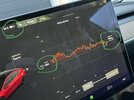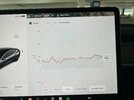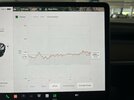Looks like it is at 77.8kWh. Full is 78.1kWh, is that correct?
The calculation 77.8 kWh is correct.
So the degradation is normal for my car?
Do I need to do anything to cycle the battery for it to reach the maximum capacity
Ok:
Remember, the method provides only the degradation threshold (not the battery capacity) when your car does not show any range loss.
Note that the degradation threshold is not necessarily equal to the "Full Pack When New" hard-coded value (in fact it usually isn't these days, though it was for a while in 2020 on the LR AWD vehicles).
Since you haven't charged to 100% in these pictures, we can't definitively say you have no range loss, but 266rmi @ 80% projects to 332.5,
so you probably are still at the max of 333 rated miles.
So, if you have NOT lost range, the value of 77.8kWh using the energy screen method,
only indicates that your battery has at LEAST that amount of energy. (Aside: the way this works is if you have more than this threshold of energy, the energy content of each rated mile is increased, hiding the extra capacity by shoving it into a fixed number of maxed-out miles (in this case max is 333).)
In addition, the constant here calculates to be 234Wh/mi (interestingly identical to the 2018/2019 Model 3 LR RWD). It is DIFFERENT than the other 2023 vehicle (79kWh/358rmi = 221Wh/mi). Note the rated line in the pictures is at about 239Wh/mi (252Wh/mi and 232Wh/mi are nearly equidistant, with 232Wh/mi being closer), which is what you'd expect for 234Wh/mi (the rated line is always 5Wh/mi higher for some reason). So that confirms the straight calculation (not really necessary to confirm, but just pointing it out).
So:
We can't see that you have any degradation. If you get 333 miles at 100%, then you do not have any appreciable capacity loss (at least, not any below the degradation threshold - of course you can lose some, and just not see the loss, as long as you stay above the threshold).
And for the record, the current 333-mile Model 3 Long Range has a degradation threshold of 77.8kWh, and a constant of 234Wh/mi. It's possible for these values to change later.
It's intriguing that the rated range has dropped so much. There's been nearly no change in capacity. I wonder if they decided to stop doing the ~0.747 scalar based on 5-cycle results? (This would mean real-world range is likely very similar between this vehicle and the 358-mile one.)
358rmi * 0.7/0.747 = 335.5rmi, so it nearly works out, especially if you consider the other pack is 79+kWh and this one is probably a little less.
Thanks for the pictures, this was very helpful to understanding what the deal is with this vehicle.





